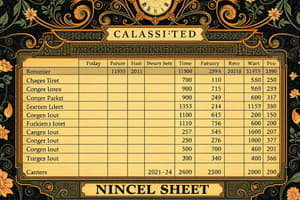Podcast
Questions and Answers
Which of the following best describes personal properties?
Which of the following best describes personal properties?
- Assets that are usually intangible
- Fixed assets that cannot be moved
- Tangible assets that are movable (correct)
- Financial obligations of a company
What is the primary purpose of preparing a balance sheet?
What is the primary purpose of preparing a balance sheet?
- To track financial obligations
- To evaluate cash flow
- To calculate net worth (correct)
- To list income and expenses
Which of the following represents a long-term liability?
Which of the following represents a long-term liability?
- Real estate mortgages (correct)
- Rent payments
- Credit card debt
- Utility bills
What type of income includes wages and self-employment income?
What type of income includes wages and self-employment income?
Which statement best defines liabilities?
Which statement best defines liabilities?
Which of the following is a common example of a short-term liability?
Which of the following is a common example of a short-term liability?
In accounting, what does equity represent?
In accounting, what does equity represent?
What does the income and expense statement track?
What does the income and expense statement track?
Which of the following is NOT one of the four phases of accounting?
Which of the following is NOT one of the four phases of accounting?
What is the primary purpose of financial statements?
What is the primary purpose of financial statements?
Which financial statement provides information about a company's profitability over a specific period?
Which financial statement provides information about a company's profitability over a specific period?
How are transactions recorded in accounting?
How are transactions recorded in accounting?
What defines your net worth?
What defines your net worth?
What term describes the accountant's interpretation of financial statements?
What term describes the accountant's interpretation of financial statements?
Which classification of expenses involves fixed payments scheduled for a specific period?
Which classification of expenses involves fixed payments scheduled for a specific period?
What is the main purpose of setting intermediate financial goals?
What is the main purpose of setting intermediate financial goals?
What is indicated by a net income or cash surplus?
What is indicated by a net income or cash surplus?
Which financial statement represents the residual interest in the assets of a company after deducting liabilities?
Which financial statement represents the residual interest in the assets of a company after deducting liabilities?
How do financial statements assist individuals in financial planning?
How do financial statements assist individuals in financial planning?
Which of the following is a step in preparing the income and expense statement?
Which of the following is a step in preparing the income and expense statement?
Which of the following is NOT a component of the SMART criteria for goal setting?
Which of the following is NOT a component of the SMART criteria for goal setting?
How are accounting transactions primarily defined?
How are accounting transactions primarily defined?
What does a net loss or cash deficit indicate?
What does a net loss or cash deficit indicate?
What is an example of how to calculate total assets from the given liabilities and net worth?
What is an example of how to calculate total assets from the given liabilities and net worth?
Why is classifying accounts important in accounting?
Why is classifying accounts important in accounting?
What critically influences your lifetime earnings according to the given information?
What critically influences your lifetime earnings according to the given information?
Which factor is NOT part of the realistic criteria for setting goals?
Which factor is NOT part of the realistic criteria for setting goals?
What does the 'attainable' criterion in SMART goals refer to?
What does the 'attainable' criterion in SMART goals refer to?
What is one significant requirement for achieving long-term financial goals?
What is one significant requirement for achieving long-term financial goals?
What is the primary function of personal financial statements?
What is the primary function of personal financial statements?
Which of the following is an example of liquid assets?
Which of the following is an example of liquid assets?
How does a balance sheet summarize financial position?
How does a balance sheet summarize financial position?
Which of the following is NOT considered a category of assets?
Which of the following is NOT considered a category of assets?
What do investments primarily aim to achieve?
What do investments primarily aim to achieve?
What type of assets are categorized as real properties?
What type of assets are categorized as real properties?
Which of the following best defines financial plans?
Which of the following best defines financial plans?
Which statement describes the purpose of an expense statement?
Which statement describes the purpose of an expense statement?
Flashcards are hidden until you start studying
Study Notes
Personal Financial Management
- Tracking progress in asset accumulation and debt reduction is essential for financial health.
- Fixed assets include land and real estate, while personal properties refer to movable items like vehicles and jewelry.
Preparing the Balance Sheet
- Assets should be listed at fair market value on the balance sheet date.
- Liabilities include all current (due within a year) and long-term obligations.
- Calculate net worth by subtracting total liabilities from total assets.
Income Statement Overview
- Income statements reflect cash inflows (income sources) and outflows (expenses).
- Common income sources include wages, investment earnings, and asset sales.
- Expenses include costs related to living, taxes, and debt repayments.
Types of Liabilities
- Current liabilities encompass debts like utility bills and rent due within one year.
- Long-term liabilities consist of mortgages and education loans due after one year.
Equity
- Equity represents the owner’s interest in the business, calculated as total assets minus total liabilities.
Financial Goal Planning
- Intermediate financial goals span 2-5 years and should be SMART: Specific, Measurable, Attainable, Realistic, and Timely.
- Align short-term goals with long-term financial objectives for coherent planning.
Career and Earnings
- A chosen career heavily influences lifetime earnings and correlates with education and skills.
Basic Accounting Concepts
- Accounting identifies, records, and communicates financial transactions to inform decision-making.
- Classification simplifies summarizing financial data and helps identify transactions under appropriate accounts.
Four Phases of Accounting
- Recording involves systematic tracking of financial transactions.
- Classifying groups similar items for better organization and reporting.
- Summarizing produces financial statements (income statement, balance sheet, cash flow statement) for analysis.
- Interpretation is crucial for using financial data in decision-making.
Personal Financial Statements
- Personal financial statements evaluate financial health and aid in informed decision-making.
- Categories of assets: Liquid Assets (easily converted to cash), Investments (long-term returns), and Real Properties (immovable assets).
Expense Categorization
- Fixed expenses are consistent payments for recurring obligations (e.g., mortgage).
- Variable expenses fluctuate and depend on usage (e.g., utilities).
Net Income or Loss
- The income and expense statement reveals the net financial result for a period, indicating either a cash surplus (income > expenses) or cash deficit (expenses > income).
- The net result impacts the equity section of the balance sheet.
Income and Expense Statement Preparation
- Record all income sources for the period.
- Establish relevant expense categories before calculating the cash surplus or deficit by subtracting total expenses from total income.
Studying That Suits You
Use AI to generate personalized quizzes and flashcards to suit your learning preferences.




